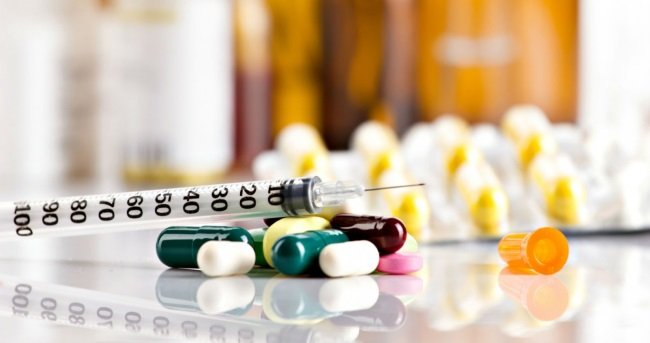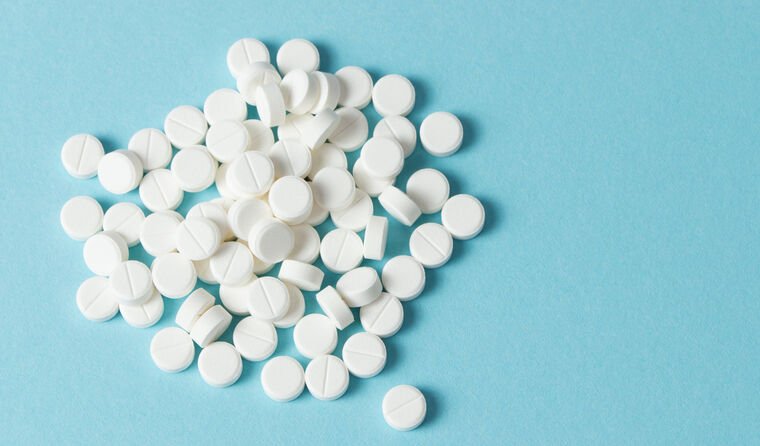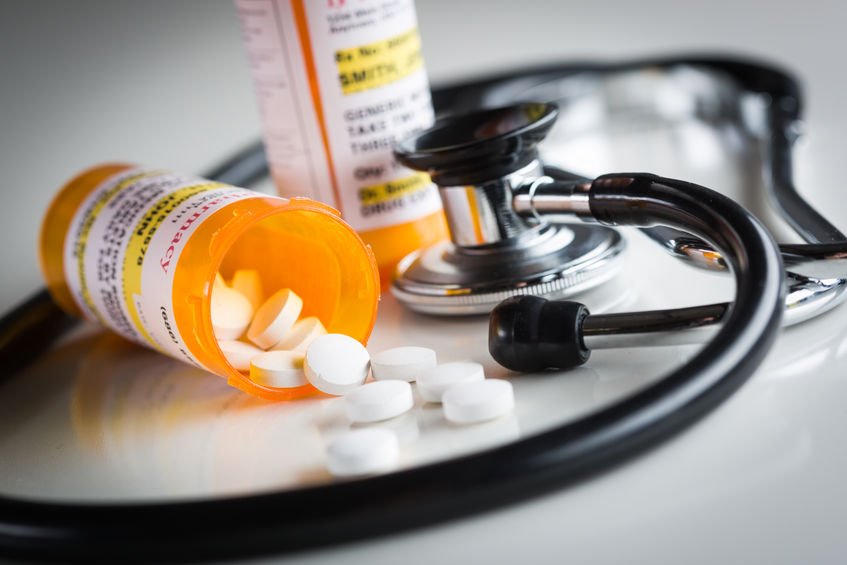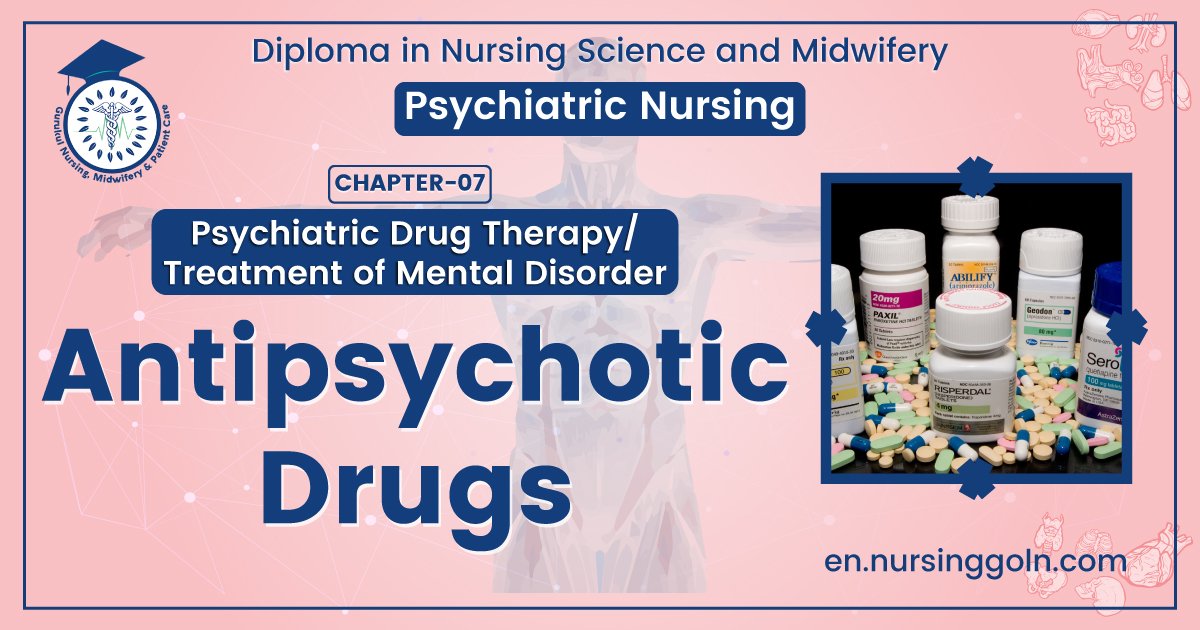Antipsychotic Drugs – This book covers the entire syllabus of “Psychiatric Nursing” prescribed by the Universities of Bangladesh- for Basic and diploma nursing students. We tried to accommodate the latest information and topics. This book is an examination-friendly setup according to the teachers’ lectures and examination questions.
At the end of the book previous university questions are given. We hope in touch with the book students’ knowledge will be upgraded and flourish. The unique way of presentation may make your reading of the book a pleasurable experience.

Antipsychotic Drugs
Mechanism of action of first generation antipsychotics:
1. These drugs mainly act as an antipsychotic by blockingD, receptors. They also block muscarinic, anticholinergic, histaminic and alpha I receptors.
2. All these conventional or typical antipsychotics are capable of producing Extrapyramidal syndromes (EPS) and often Tardive dyskinesia (TD) from D: receptors blocking property especially in nigrostriatal pathway.
[Ref: S Nambi/24/178]
Some anti-psychotic drugs:
| Group | Drug | Usual dose |
Phenothiazines | Chlorpromazine | 100-1500 mg daily |
| Trifluoperazine | 5-30 mg daily | |
| Fluphenazine | 20-100 mg fortnightly | |
| Butyrophenones | Haloperidol | 5-30 mg daily |
| Thioxanthenes | Flupentixol decanoate | 20-200 mg fortnightly |
Diphenylbutylpiperidines | Pimozide | 4-30 mg daily |
Substituted benzamides | Sulpiride | 600-1800 mg daily |
Dibenzodiazepine | Clozapine | 25-900 mg daily |
| Benzisoxazole | Risperidone | 2-16 mg daily |
Thienobenzodiazepines | Olanzapine | 5.-20 mg daily |
Dibenzothiazepines | Quetiapine | 200-800 mg daily |
[Ref-Davidson’s/24 edition]
Side effects of antipsychotic drug:
| First generation antipsychotics | Second generation antipsychotics |
Anticholinergic effects:
Endocrine effects:
Extrapyramidal side-effects (EPS): 1. Pseudoparkinsonism (tremor, shuffling gait, rigidity, drooling of saliva, mask like face)- may appear in 1-5 days following antipsychotic medications. 2. Acute dystonia-occurs soon after the initiation of treatment. Dystonia is the sustained muscle contraction and the manifestations include –
3. Akathisia (motor restlessness) 4. Tardive dyskinesia 5. Neuroleptic malignant syndrome (NMS) | 1. Weight gain-common especially in olanzapine, clozapine and zotepine 2. Blood dyscrasias- Agranulocytosis a rare side effects with clozapineperiodic 3. WBC and absolute neutrophil count to be done 4. Diabetes 5. Metabolic syndrome-
|
[Ref: S Nambi/24/178-181]
Benefits of second generation (SGA) over first generation:
1. The Advantages of SGA (atypicals)
2. Beneficial effects on both positive and negative symptoms
3. Low incidence of EPS (Extra Pyramidal Symptom), TD (Tardive Dyskinesia) and NMS (Neuroleptic Malignant Syndrome)
4. Low stimulation of prolactin secretion
5. Effective in treatment resistant cases
6. Dopamine blocking actions is mainly on Mesolimbic pathway, avoiding nigrostriatal pathway
7. Atypicals have low affinity towards D, receptors but also to D, and other receptors like serotonin (SHTr)
8. The atypicals act on SDA concepts-both serotonin and dopamine antagonist actions.
[Ref: S Nambi/24/179]

Differences between first and second generation antipsychotics:
| First generation/typical/older antipsychotics | Second generation/atypical/newer antipsychotics |
| Blocks dopamine, muscarinic, histamine and alpha I receptors | Block dopaminergic and seretonine receptor |
| Has high affinity for D2 | Low affinity for D2 |
| Acts on nigrostrial pathway | Acts on mesolimbic pathway |
| Incidence of development of EPS, TD and NMS is high | Incidence of development of EPS, TD and NMS is low |
| Prolactin secretion is more | Prolactin secretion is less |
[Ref: S Nambi/24/179)]
EPS (Extra Pyramidal Symptom):
Clinical feature:
1. Pseudoparkinsonism (tremor, shuffling gait, rigidity, drooling of saliva, mask like face)-may appear in 1-5 days following antipsychotic medications.
2. Acute dystonia
3. Akathisia
4. Tardive dyskinesia
5. Neuroleptic malignant syndrome (NMS)
Treatment
1. Lowering the dosage of the antipsychotic drug
2. Changing to a different antipsychotic drug
3. Administering anticholenergic drug as it dissociates side effects of drugs
Tardive dyskinesia (TD):
Tardive dyskinesia (TD) is along-term complication of antipsychotics mainly with D. antagonists and is hypothesized to be due to supersensitization of D₂ receptors in nigrostriatal pathway resulting from prolonged D₂ blockage.
Clinical features:
The most common dyskinesias include chewing and sucking (Oro-bucco-linguo-masticatory) movements, grimacing and choreoathetoid movements.
Treatment:
Till date, no effective treatment of TD is available.
Neuroleptic malignant syndrome (NMS):
Neuroleptic malignant syndrome (NMS) is a rare but extremely serious complication of antipsychotics especially with high potency D₂ antagonists like haloperidol.
Clinical features:
1. Fluctuating
2. Consciousness
3. Hyperthermia,
4. Muscle rigidity and
5. Automatic instability.
Lab findings:
1. Increased white blood cell count,
2. Cpk and
3. Serum creatinine.
Treatment:
1. Treatment is mainly supportive.
2. The offending drug should be discontinued. Electrolytes and fluid balance should be maintained. Dantrolene, bromocriptine and amantadine have been tried. Mortality rate is quite high (20-40%).
[Ref: S Nambi/24/179]

Depot preparation antipsychotics:
| Generic name | Dosage range |
| Injection Fluphenazinedeconate | 25 mg once in 2 weeks |
| Injection Haloperidol deconate | 50 mg once in 2-4 weeks |
| Injection Risperidone-long-acting | 25 mg once in 2-4 weeks |
| Injection Flupenthixol | 40 mg once in 1-4 weeks |
Preference of depot preparation:
Depot preparations are often preferable in:
1. Maintenance treatment of long-term psychotic disorders,
2. Treatment resistant cases
3. Unwilling and non-cooperative patients.
4. Patients with poor drug compliance.
[Ref: S Nambi/2/181]
Contraindications of psychiatric drugs:
1. Known hypersensitivity to any of the drug
2. Pregnancy
3. Renal impairment
4. Liver disease
5. Cardiovascular disorder
6. Lactating mother
[Ref: S Nambi/24/1811]

Nursing care in case of antipsychotic side effects:
1. Teach the clients about side-effects of antipsychotic drugs and if any observed ask them to report to the physician instead of discontinuing the medication
2. Teach the clients, the methods of managing and avoiding unpleasant side-effects and maintaining the medication regimen
3. Ask the client to take sugar free fluids and eating sugar free hard candy to ease dry mouth
4. Avoid calorie beverages and candy to avoid weight gain
5. Exercise
6. Consuming water and bulk form foods in diet to overcome constipation
7. Stool softners can be advised
8. Usage of sunscreen lotions to overcome photosensitivity
9. Monitor sleeping pattern
10. Advise them to avoid driving as they appear to be drowsy.
[Ref: KP Neeraja/1″/Vol-1/279]
Read more:
